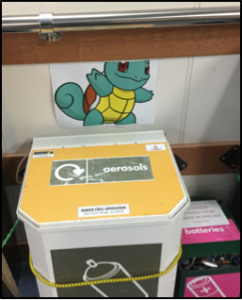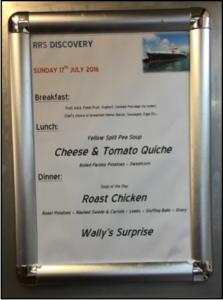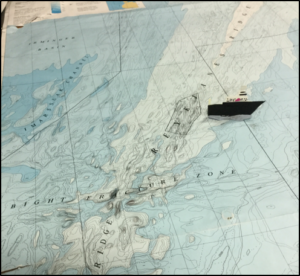OSNAP Year 3 Leg 1, 17-July-2016, 58d 45.19N 30d 16.38W, Back on The Line.
by Heather Furey
We are nearing the end of this cruise. We have four more CTD stations to take on the OSNAP line,  one ‘cal-dip’ (where instruments are attached to the CTD frame and calibrated in deep water), one mooring to deploy, having recovered its companion mooring in pea-soup fog this afternoon, and one final mooring to turn-around (both recover and deploy). My head is on land today, laying out plans for hiking in Iceland when I get there, and for getting home to see my peeps. I think it is because we went so close to Reykjavik when Greg got picked up by helicopter.
one ‘cal-dip’ (where instruments are attached to the CTD frame and calibrated in deep water), one mooring to deploy, having recovered its companion mooring in pea-soup fog this afternoon, and one final mooring to turn-around (both recover and deploy). My head is on land today, laying out plans for hiking in Iceland when I get there, and for getting home to see my peeps. I think it is because we went so close to Reykjavik when Greg got picked up by helicopter.
But, we are still at sea.
Here on board, a few things: First, Wally’s Surprise was served at dinner tonight. I can’t tell you what it was, because that would spoil the surprise for the next Leg’s science crew, but it was pretty darned good. Excellent, in fact. Second, some mystery person has been putting up Pokémon monsters hidden in plain sight around the ship. Pokémon Go, here. I do not have much to say about that, just that it is happening.
 Now that we are nearing the end of the scheduled science, we get a little time to play! Most cruises have a few ‘weather days’ built in to the schedule, for things like gales, or getting personnel helicoptered off the ship, or equipment repair … whatever comes up. See how the ship is sort of near the Bight Fracture Zone? We seem to still have a breath of time left, and will use it to go back to the Bight!
Now that we are nearing the end of the scheduled science, we get a little time to play! Most cruises have a few ‘weather days’ built in to the schedule, for things like gales, or getting personnel helicoptered off the ship, or equipment repair … whatever comes up. See how the ship is sort of near the Bight Fracture Zone? We seem to still have a breath of time left, and will use it to go back to the Bight!
Part of measuring the overturning circulation (O-SNAP=Overturning Circulation of the Subpolar North Atlantic Program) is measuring the bottom currents. The Iceland-Scotland Overflow Water makes up the bottom current that flow southward from the shallow sill between Iceland and Scotland. The dense overflow water sinks to the deep Iceland Basin and forms a boundary current travelling from north to south along the west side of the Iceland Basin, which is also the east flank of the Reykjanes Ridge. But, this “flavor” water is also found in the western Atlantic Basin and it is still not quite known exactly how this water gets from one basin to the other.
This is where the fracture zones come in. Fracture zones are deep breaks in the ridge, like missing vertebrae in the spine of the North Atlantic. Historically, if you open a research paper that is puzzling out this mystery, you would see a figure showing the deep ISOW water arrow following the eastern flank of the Reykjanes Ridge, turning into the western Atlantic through the Charlie Gibbs Fracture Zone further south. This is the deepest and widest fracture zone in the Reykjanes-Mid-Atlantic Ridge system. But these days, we think that some of (all of?) the shallower portion of the deep ISOW current flows through upstream cracks in the Reykjanes Ridge into the western Atlantic. Makes sense to me. How much? Modelers have estimates, but no one has measured it.
vertebrae in the spine of the North Atlantic. Historically, if you open a research paper that is puzzling out this mystery, you would see a figure showing the deep ISOW water arrow following the eastern flank of the Reykjanes Ridge, turning into the western Atlantic through the Charlie Gibbs Fracture Zone further south. This is the deepest and widest fracture zone in the Reykjanes-Mid-Atlantic Ridge system. But these days, we think that some of (all of?) the shallower portion of the deep ISOW current flows through upstream cracks in the Reykjanes Ridge into the western Atlantic. Makes sense to me. How much? Modelers have estimates, but no one has measured it.
The Bight is a shallower fracture zone upstream in an Iceland-Scotland-Overflow-Water sense. We went there first in 2014, on the first OSNAP cruise, knowing that that no-one had ever taken CTD stations in this fracture zone. Second time in all of history the Bight will be surveyed? Sign me up, let’s go!
P.S. Greg is on a plane home to Miami as I write, back to family and good care. Safe and sound.